Dried Leaves
RSP 13120
Grower: Zamir Punja
General Information
- Sample Name
- Dried Leaves-20240416
- Accession Date
- April 24, 2024
- Reported Plant Sex
- Female
- Report Type
- Whole-Genome Sequencing
- Microbiome
- Krona Plot
- Fungal Microbiome
- Krona Plot
- Bacterial Microbiome
- Krona Plot
- Viral Microbiome
- Krona Plot
The strain rarity visualization shows how distant the strain is from the other cultivars in the Kannapedia database. The y-axis represents genetic distance, getting farther as you go up. The width of the visualization at any position along the y-axis shows how many strains there are in the database at that genetic distance. So, a common strain will have a more bottom-heavy shape, while uncommon and rare cultivars will have a visualization that is generally shifted towards the top.
Chemical Information
Cannabinoid and terpenoid information provided by the grower.
Cannabinoids
No information provided.
Terpenoids
No information provided.
Genetic Information
- Plant Type
- Type I
File Downloads
The bell curve in the heterozygosity visualization shows the distribution of heterozygosity levels for cannabis cultivars in the Kannapedia database. The green line shows where this particular strain fits within the distribution. Heterozygosity is associated with heterosis (aka hybrid vigor) but also leads to the production of more variable offspring. When plants have two genetically different parents, heterozygosity levels will be higher than if it has been inbred or backcrossed repeatedly.
The ratio of reads mapped to Y-contigs to reads mapped to the whole Cannabis genome (Y-ratios) has been demonstrated to be strongly correlated with plant sex typing. This plot shows the distribution of Y-ratios for all samples in our database which were sequenced with the same method (panel or WGS) as this sample and where this sample falls in the distribution.
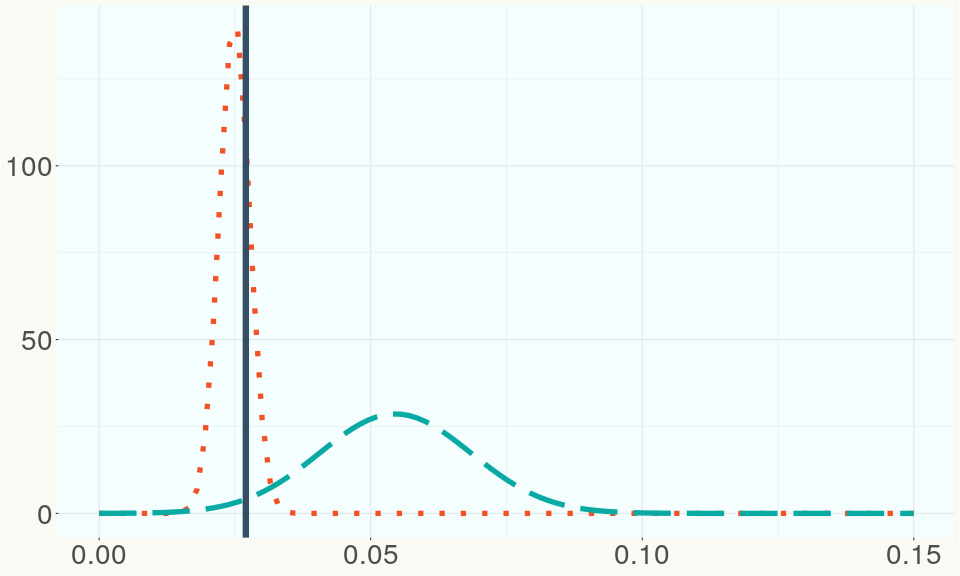
This chart represents the Illumina sequence coverage over the Bt/Bd allele. These are the three regions in the cannabis genome that impact THCA, CBDA, CBGA production. Coverage over the Active CBDAS gene is highly correlated with Type II and Type III plants as described by Etienne de Meijer. Coverage over the THCA gene is highly correlated with Type I and Type II plants but is anti-correlated with Type III plants. Type I plants require coverage over the inactive CBDA loci and no coverage over the Active CBDA gene. Lack of coverage over the Active CBDA and Active THCA allele are presumed to be Type IV plants (CBGA dominant). While deletions of entire THCAS and CBDAS genes are the most common Bt:Bd alleles observed, it is possible to have plants with these genes where functional expression of the enzyme is disrupted by deactivating point mutations (Kojoma et al. 2006).
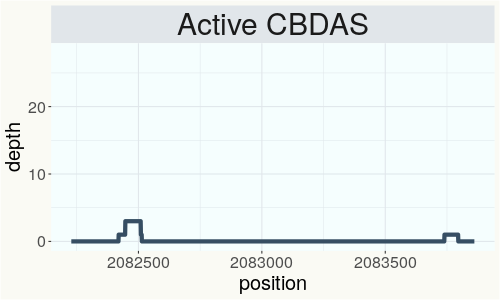
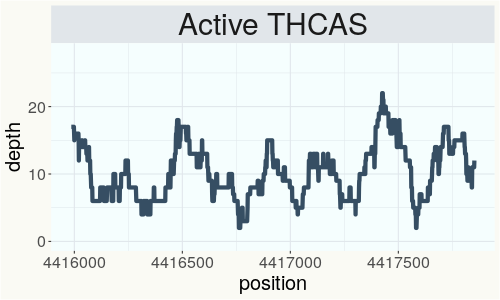
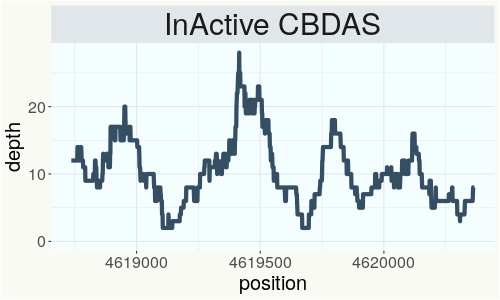
This chart represents the Illumina sequence coverage over the CBCA synthase gene.
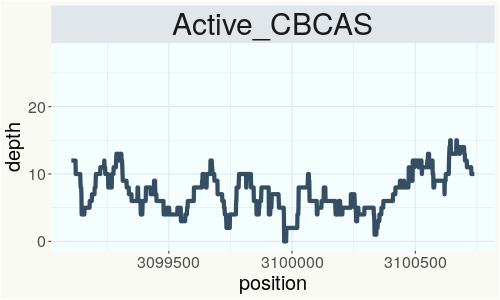
Variants (THCAS, CBDAS, and CBCAS)
No variants to report
Variants (Select Genes of Interest)
| PHL-2 | c.2830A>G | p.Asn944Asp | missense variant | moderate | contig2621 | 342873 | A/G |
|
| DXR-2 | c.431C>G | p.Ala144Gly | missense variant | moderate | contig380 | 287760 | G/C | |
| FAD2-2 | c.23G>A | p.Ser8Asn | missense variant | moderate | contig83 | 1803346 | C/T |
|
| ELF3 | c.520A>C | p.Asn174His | missense variant | moderate | contig97 | 242226 | A/C | |
| ELF3 | c.574A>G | p.Asn192Asp | missense variant | moderate | contig97 | 242280 | A/G | |
| aPT4 | c.35A>C | p.Gln12Pro | missense variant | moderate | contig121 | 2828691 | A/C |
|
| HDS-1 | c.1378G>A | p.Val460Ile | missense variant | moderate | contig1891 | 886370 | C/T |
|
| FLD | c.2686G>A | p.Ala896Thr | missense variant | moderate | contig1450 | 2044848 | C/T | |
| PKSB-3 | c.1652A>G | p.Glu551Gly | missense variant | moderate | contig93 | 3339759 | A/G |
|
Nearest genetic relatives (All Samples)
- 0.078 JFG (RSP13085)
- 0.085 JFG (RSP12927)
- 0.095 Powdered Donuts (RSP12939)
- 0.116 JFG (RSP12933)
- 0.203 Old Family Purple (RSP12098)
- 0.206 Skywalker OG (RSP10837)
- 0.208 BF (RSP12931)
- 0.216 SFVxTK (RSP11072)
- 0.217 BF (RSP13086)
- 0.219 Champelli Red 4 (RSP12804)
- 0.226 501st OG (RSP11241)
- 0.228 Jilly bean (RSP11230)
- 0.229 PG (RSP12928)
- 0.230 East side OG (RSP12089)
- 0.230 PG (RSP12934)
- 0.231 PG (RSP13088)
- 0.232 BF (RSP12937)
- 0.233 Durban Poison 1 (RSP11013)
- 0.233 Noetic OG (RSP11455)
- 0.234 RKM-2018-012 (RSP11103)
Most genetically distant strains (All Samples)
- 0.474 Cherry Blossom (RSP11317)
- 0.465 Northern Skunk (RSP11456)
- 0.442 Cherry Fog XL (RSP11458)
- 0.435 80E (RSP11213)
- 0.433 Cherry Blossom (RSP11298)
- 0.432 Cherry Blossom (RSP11323)
- 0.431 Cherry Blossom (RSP11311)
- 0.429 Cherry Blossom (RSP11330)
- 0.429 Cherry Blossom (RSP11328)
- 0.429 Cherry Blossom (RSP11314)
- 0.423 Cherry Blossom (RSP11306)
- 0.419 Cherry Blossom (RSP11334)
- 0.418 Cherry Blossom (RSP11324)
- 0.417 Cherry Blossom (RSP11318)
- 0.415 Cherry Blossom (RSP11309)
- 0.415 Cherry Blossom (RSP11312)
- 0.415 IUP3 (SRR14708256)
- 0.414 Jamaican Lion (RSP12916)
- 0.414 Ruderalis Indica (SRR14708267)
- 0.414 Tanao Sri-white-T1 (RSP11658)
Nearest genetic relative in Phylos dataset
- Overlapping SNPs:
- 91
- Concordance:
- 63
Nearest genetic relative in Lynch dataset
- Overlapping SNPs:
- 3
- Concordance:
- 3
Blockchain Registration Information
- Transaction ID
-
d6af39a9d9082ea5
875967fbf9c74029 5f7cba43660f6dc0 605c4f2966458b1b - Stamping Certificate
- Download PDF (39.8 KB)
- SHASUM Hash
-
64055202c904763821085343499f7d43 286770f71f8bbc34 9ad7ecdb89fe6dfe